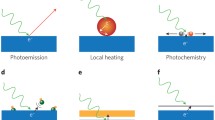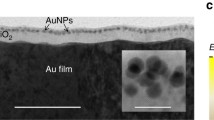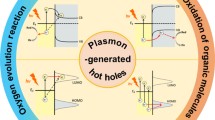Abstract
Plasmon-induced hot electrons have attracted much recent attention due to its promising potential in photocatalysis and other light harvesting applications. Surface plasmon of metal nanoparticles decays nonradiatively to generate energetic electrons, referred to as hot electrons. Since hot electrons can be transferred to a chemically attached acceptor, this process is potentially useful for technological applications. Plasmon-induced hot-electron transfer is known to occur via two key mechanisms: indirect transfer and direct transfer. For hot-electron-driven catalysis, the energy of hot electrons needs to overlap with the unoccupied orbitals of the reactant, and the particular chemical channel can be selectively enhanced by controlling the energy distribution of hot electrons. High-energy hot electrons generated by plasmon decay also could contribute to nonlinear responses, which is essential for fundamental understanding of the optical nonlinearity associated with quantum and nonlocal effects on the atomic level. This chapter focuses on the recent advances in the understanding of plasmon-induced hot electrons and highlights its application in photocatalysis.
Access this chapter
Tax calculation will be finalised at checkout
Purchases are for personal use only
Similar content being viewed by others
References
Hertz, H. (1887). Ueber einen Einfluss des ultravioletten Lichtes auf die electrische Entladung. Annals of Physical Chemistry, 267, 983–1000.
Einstein, A. (1905). Über einen die Erzeugung und Verwandlung des Lichtes betreffenden heuristischen Gesichtspunkt. Annals of Physics, 322, 132–148.
Planck, M. (1901). Ueber das gesetz der energieverteilung im normalspectrum. Annals of Physics, 309, 553–563.
Brongersma, M. L., Halas, N. J., & Nordlander, P. (2015). Plasmon-induced hot carrier science and technology. Nature Nanotechnology, 10, 25–34.
Hüfner, S. (2003). Photoelectron spectroscopy: Principles and applications. Springer.
Atwater, H. A. (2007). The promise of plasmonics. Scientific American, 296, 56–62.
Clavero, C. (2014). Plasmon-induced hot-electron generation at nanoparticle/metal-oxide interfaces for photovoltaic and photocatalytic devices. Nature Photonics, 8, 95–103.
Atwater, H. A., & Polman, A. (2010). Plasmonics for improved photovoltaic devices. Nature Materials, 9, 205–213.
Tian, Y., & Tatsuma, T. (2005). Mechanisms and applications of plasmon-induced charge separation at TiO2 films loaded with gold nanoparticles. Journal of the American Chemical Society, 127, 7632–7637.
Linic, S., Christopher, P., & Ingram, D. B. (2011). Plasmonic-metal nanostructures for efficient conversion of solar to chemical energy. Nature Materials, 10, 911–921.
Wu, K., Chen, J., McBride, J. R., & Lian, T. (2015). Efficient hot-electron transfer by a Plasmon-induced interfacial charge-transfer transition. Science, 349, 632–635.
Linic, S., Aslam, U., Boerigter, C., & Morabito, M. (2015). Photochemical transformations on plasmonic metal nanoparticles. Nature Materials, 14, 567–576.
Zhang, Z., Zhang, C., Zheng, H., & Xu, H. (2019). Plasmon-driven catalysis on molecules and nanomaterials. Accounts of Chemical Research, 52, 2506–2515.
Zhang, Y., He, S., Guo, W., Hu, Y., Huang, J., Mulcahy, J. R., & Wei, W. D. (2018). Surface-Plasmon-driven hot electron photochemistry. Chemical Reviews, 118, 2927–2954.
Sönnichsen, C., et al. (2002). Drastic reduction of plasmon dam** in gold nanorods. Physical Review Letters, 88, 077402.
Lehmann, J., et al. (2000). Surface plasmon dynamics in silver nanoparticles studied by femtosecond time-resolved photoemission. Physical Review Letters, 85, 2921–2924.
Hao, F., et al. (2008). Symmetry breaking in plasmonic nanocavities: Subradiant LSPR sensing and a tunable Fano resonance. Nano Letters, 8, 3983–3988.
Manjavacas, A., Liu, J., Kulkarni, V., & Nordlander, P. (2014). Plasmon-induced hot carriers in metallic nanoparticles. ACS Nano, 8, 7630–7638.
Aslam, U., Rao, V. G., Chavez, S., & Linic, S. (2018). Catalytic conversion of solar to chemical energy on plasmonic metal nanostructures. Nature Catalysis, 1, 656–665.
Watanabe, K., Menzel, D., Nilius, N., & Freund, H. J. (2006). Photochemistry on metal nanoparticles. Chemical Reviews, 106, 4301–4320.
Lisowski, M., et al. (2004). Ultra-fast dynamics of electron thermalization, cooling and transport effects in Ru(001). Applied Physics A: Materials Science & Processing, 78, 165–176.
Inouye, H., Tanaka, K., Tanahashi, I., & Hirao, K. (1998). Ultrafast dynamics of nonequilibrium electrons in a gold nanoparticle system. Physical Review B, 57, 11334–11340.
Fang, Z., Zhen, Y. R., Neumann, O., Polman, A., Garcia de Abajo, F. J., Nordlander, P., & Halas, N. J. (2013). Evolution of light-induced vapor generation at a liquid-immersed metallic nanoparticle. Nano Letters, 13, 1736–1742.
Frischkorn, C., & Wolf, M. (2006). Femtochemistry at metal surfaces: Nonadiabatic reaction dynamics. Chemical Reviews, 106, 4207–4233.
Du, L., Furube, A., Hara, K., Katoh, R., & Tachiya, M. (2013). Ultrafast Plasmon induced electron injection mechanism in gold-TiO2 nanoparticle system. Journal of Photochemistry and Photobiology, C: Photochemistry Reviews, 15, 21–30.
Liu, J. G., Zhang, H., Link, S., & Nordlander, P. (2018). Relaxation of Plasmon-induced hot carriers. ACS Photonics, 5, 2584–2595.
Link, S., & El-Sayed, M. (1999). Spectral properties and relaxation dynamics of surface plasmon electronic oscillations in gold and silver nanodots and nanorods. The Journal of Physical Chemistry B, 103, 8410–8426.
Dowgiallo, A. M., & Knappenberger, K. L. (2011). Ultrafast electron-phonon coupling in hollow gold Nanospheres. Physical Chemistry Chemical Physics, 13, 21585–21592.
Minutella, E., Schulz, F., & Lange, H. (2017). Excitation-dependence of Plasmon-induced hot electrons in gold nanoparticles. Journal of Physical Chemistry Letters, 8, 4925–4929.
Su, M., et al. (2019). Ultrafast electron dynamics in single aluminum nanostructures. Nano Letters, 19, 3091–3097.
Kreibig, U., & Vollmer, M. (1995). Optical properties of metal clusters. Springer.
Langhammer, C., Yuan, Z., Zorić, I., & Kasemo, B. (2006). Plasmonic properties of supported Pt and Pd nanostructures. Nano Letters, 6, 833–838.
Yu, K., Tian, Y., & Tatsuma, T. (2006). Size effects of gold nanaoparticles on plasmon-induced photocurrents of gold–TiO2 nanocomposites. Physical Chemistry Chemical Physics, 8, 5417–5420.
Nishijima, Y., et al. (2012). Near-infrared plasmon-assisted water oxidation. Journal of Physical Chemistry Letters, 3, 1248–1252.
Nishijima, Y., Ueno, K., Yokota, Y., Murakoshi, K., & Misawa, H. (2010). Plasmon-assisted photocurrent generation from visible to near-infrared wavelength using a Au-nanorods/TiO2 electrode. Journal of Physical Chemistry Letters, 1, 2031–2036.
Mubeen, S., et al. (2013). An autonomous photosynthetic device in which all charge carriers derive from surface plasmons. Nature Nanotechnology, 8, 247–251.
Skoplaki, E., & Palyvos, J. A. (2009). On the temperature dependence of photovoltaic module electrical performance: A review of efficiency/power correlations. Solar Energy, 83, 614–624.
Rossi, T. P., Erhart, P., & Kuisma, M. (2020). Hot-carrier generation in Plasmonic nanoparticles: The importance of atomic structure. ACS Nano, 14, 9963–9971.
Kazuma, E., Sakai, N., & Tatsuma, T. (2011). Nanoimaging of localized plasmon-induced charge separation. Chemical Communications, 47, 5777–5779.
Kazuma, E., & Tatsuma, T. (2013). Photoelectrochemical analysis of allowed and forbidden multipole plasmon modes of polydisperse Ag nanorods. Journal of Physical Chemistry C, 117, 2435–3441.
Knight, M. W., Sobhani, H., Nordlander, P., & Halas, N. J. (2011). Photodetection with active optical antennas. Science, 332, 702–704.
Kumar, P. V., et al. (2019). Plasmon-induced direct hot-carrier transfer at metal-acceptor interfaces. ACS Nano, 13, 3188–3195.
Chen, Y.-C., Hsu, Y.-K., Popescu, R., Gerthsen, D., Lin, Y. G., & Feldmann, C. (2018). Au@Nb@HxK1−xNbO3 nanopeapods with near-infrared active plasmonic hot-electron injection for water splitting. Nature Communications, 9, 232.
Foerster, B., Joplin, A., Kaefer, K., Celiksoy, S., Link, S., & Sonnichsen, C. (2017). Chemical Interface dam** depends on electrons reaching the surface. ACS Nano, 11, 2886–2893.
Kazuma, E., Jung, J., Ueba, H., Trenary, M., & Kim, Y. (2018). Real-space and real-time observation of a plasmon-induced chemical reaction of a single molecule. Science, 360, 521–525.
Wu, K., Chen, J., McBride, J. R., & Lian, T. (2015). Efficient hot-electron transfer by a Plasmon- induced interfacial charge-transfer transition. Science, 349, 632–635.
Tan, S., Dai, Y., Zhang, S., Liu, L., Zhao, J., & Petek, H. (2018). Coherent electron transfer at the Ag/Graphite heterojunction Interface. Physical Review Letters, 120, 126801.
Zhang, J., Guan, M., Lischner, J., Meng, S., & Prezhdo, O. V. (2019). Coexistence of different charge-transfer mechanisms in the hot-carrier dynamics of hybrid Plasmonic nanomaterials. Nano Letters, 19, 3187–3193.
Runge, E., & Gross, E. K. U. (1984). Density-functional theory for time-dependent systems. Physical Review Letters, 52, 997–1000.
Ma, J., & Gao, S. (2019). Plasmon-induced electron−hole separation at the Ag/TiO2(110) Interface. ACS Nano, 13, 13658–13667.
Liu, Z. W., Hou, W. B., Pavaskar, P., Aykol, M., & Cronin, S. B. (2011). Plasmon resonant enhancement of photocatalytic water splitting under visible illumination. Nano Letters, 11, 1111–1116.
Yan, L., Xu, J., Wang, F., & Meng, S. (2018). Plasmon-induced ultrafast hydrogen production in liquid water. Journal of Physical Chemistry Letters, 9, 63–69.
Golubev, A. A., Khlebtsov, B. N., Rodriguez, R. D., Chen, Y., & Zahn, D. R. T. (2018). Plasmonic heating plays a dominant role in the Plasmon-induced photocatalytic reduction of 4-Nitrobenzenethiol. Journal of Physical Chemistry C, 122, 5657–5663.
Zhang, C., Lu, J., **, N., Dong, L., Fu, Z., Zhang, Z., & Zheng, H. (2019). Plasmon driven rapid in-situ formation of luminescence single crystal nanoparticle. Small, 15, 1901286.
Christopher, P., **n, H., & Linic, S. (2011). Visible-light-enhanced catalytic oxidation reactions on plasmonic silver nanostructures. Nature Chemistry, 3, 467–472.
Yan, L., Ding, Z., Song, P., Wang, F., & Meng, S. (2015). Plasmon-induced dynamics of H2 splitting on a silver atomic chain. Applied Physics Letters, 107, 083102.
Yan, L., Wang, F., & Meng, S. (2016). Quantum mode selectivity of Plasmon-induced water splitting on gold nanoparticles. ACS Nano, 10, 5452–5458.
Kale, M. J., Avanesian, T., **n, H., Yan, J., & Christopher, P. (2014). Controlling catalytic selectivity on metal nanoparticles by direct photoexcitation of adsorbate–metal bonds. Nano Letters, 14, 5405–5412.
Langhammer, C., Kasemo, B., & Zoric, I. (2007). Absorption and scattering of light by Pt, Pd, Ag, and Au nanodisks: Absolute cross sections and branching ratios. The Journal of Chemical Physics, 126, 194702.
Naldoni, A., Montini, T., Malara, F., Mróz, M. M., Beltram, A., Virgili, T., Boldrini, C. L., Marelli, M., Romero-Ocaña, I., Delgado, J. J., Dal Santo, V., & Fornasiero, P. (2017). Hot electron collection on Brookite Nanorods lateral facets for Plasmon-enhanced water oxidation. ACS Catalysis, 7, 1270–1278.
Sakamoto, H., Ohara, T., Yasumoto, N., Shiraishi, Y., Ichikawa, S., Tanaka, S., & Hirai, T. (2015). Hot-electron-induced highly efficient O2 activation by Pt nanoparticles supported on Ta2O5 driven by visible light. Journal of the American Chemical Society, 137, 9324–9332.
Lupetti, M., Hengster, J., Uphues, T., & Scrinzi, A. (2014). Attosecond photoscopy of plasmonic excitations. Physical Review Letters, 113, 113903.
Mukherjee, S., Libisch, F., Large, N., Neumann, O., Brown, L. V., Cheng, J., Lassiter, J. B., Carter, E. A., Nordlander, P., & Halas, N. J. (2013). Hot electrons do the impossible: Plasmon-induced dissociation of H2 on Au. Nano Letters, 13, 240–247.
Seemala, B., Therrien, A. J., Lou, M., Li, K., Finzel, J. P., Qi, J., Nordlander, P., & Christopher, P. (2019). Plasmon-mediated catalytic O2 dissociation on Ag nanostructures: Hot electrons or near fields? ACS Energy Letters, 4, 1803–1809.
Townsend, E., & Bryant, G. W. (2014). Which resonances in small metallic nanoparticles are Plasmonic? Journal of Optics, 16, 114022.
Townsend, E., & Bryant, G. W. (2012). Plasmonic properties of metallic nanoparticles: The effects of size quantization. Nano Letters, 12, 429–434.
Ma, J., Wang, Z., & Wang, L. W. (2015). Interplay between Plasmon and single-particle excitations in a metal nanocluster. Nature Communications, 6, 10107.
Grinblat, G., Li, Y., Nielsen, M. P., Oulton, R. F., & Maier, S. A. (2016). Enhanced third harmonic generation in single germanium Nanodisks excited at the Anapole mode. Nano Letters, 16, 4635.
Mohamed, M. B., Volkov, V., Link, S., & El-Sayed, M. A. (2000). The ‘lightning’ gold nanorods: Fluorescence enhancement of over a million compared to the gold metal. Chemical Physics Letters, 317, 517.
Kauranen, M., & Zayats, A. V. (2012). Calculated absorption and scattering properties of gold nanoparticles of different size, shape, and composition: Applications in biological imaging and biomedicine. Nature Photonics, 6, 737.
Narang, P., Sundararaman, R., Jermyn, A. S., Goddard, W. A., & Atwater, H. A. (2016). Cubic nonlinearity driven up-conversion in high-field plasmonic hot carrier systems. Journal of Physical Chemistry C, 120, 21056.
Van Sark, W., de Wild, J., Rath, J. K., Meijerink, A., & Schropp, R. E. I. (2013). Upconversion in solar cells. Nanoscale Research Letters, 8, 81.
Arppe, R., Näreoja, T., Nylund, S., Mattsson, L., Koho, S., Rosenholm, J. M., Soukka, T., & Schäferling, M. (2014). Photon upconversion sensitized nanoprobes for sensing and imaging of pH. Nanoscale, 6, 6837.
Zhang, Y., Grady, N. K., Ayala-Orozco, C., & Halas, N. J. (2011). Three-dimensional nanostructures as highly efficient generators of second harmonic light. Nano Letters, 11, 5519.
Hanke, T., Cesar, J., Knittel, V., Trügler, A., Hohenester, U., Leitenstorfer, A., & Bratschitsch, R. (2012). Tailoring spatiotemporal light confinement in single plasmonic nanoantennas. Nano Letters, 12, 992.
Yan, L., Guan, M., & Meng, S. (2018). Plasmon-induced nonlinear response of silver atomic chains. Nanoscale, 10, 8600.
Li, S., & Jones, R. R. (2016). High-energy electron emission from metallic nano-tips driven by intense single-cycle terahertz pulses. Nature Communications, 7, 13405.
Kale, M. J., Avanesian, T., & Christopher, P. (2014). Direct photocatalysis by plasmonic nanostructures. ACS Catalysis, 4, 116.
Cortés, E., Besteiro, L. V., Alabastri, A., Baldi, A., Tagliabue, G., Demetriadou, A., & Narang, P. (2020). Challenges in plasmonic catalysis. ACS Nano, 14, 16202–16219.
Acknowledgments
This work was supported by the National Key R&D Program of China (Grant No. 2020YFA0211300), the National Natural Science Foundation of China (Nos. 92050112, 12074237 and 12004233), and the Fundamental Research Funds for Central Universities (GK201701008).
Author information
Authors and Affiliations
Corresponding author
Editor information
Editors and Affiliations
Rights and permissions
Copyright information
© 2022 The Author(s), under exclusive license to Springer Nature Switzerland AG
About this chapter
Cite this chapter
Yan, L., Fu, Z., Zhang, Z. (2022). Plasmon-Induced Hot Electrons in Metallic Nanoparticles. In: Yu, P., Xu, H., Wang, Z.M. (eds) Plasmon-enhanced light-matter interactions. Lecture Notes in Nanoscale Science and Technology, vol 31. Springer, Cham. https://doi.org/10.1007/978-3-030-87544-2_7
Download citation
DOI: https://doi.org/10.1007/978-3-030-87544-2_7
Published:
Publisher Name: Springer, Cham
Print ISBN: 978-3-030-87543-5
Online ISBN: 978-3-030-87544-2
eBook Packages: Physics and AstronomyPhysics and Astronomy (R0)




